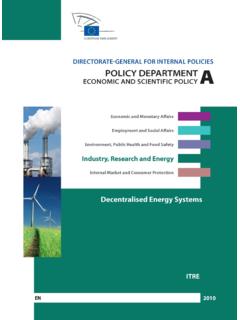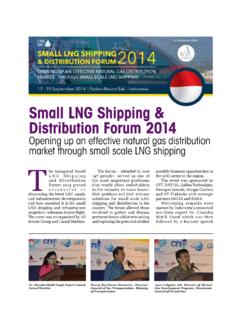Transcription of Cities and Climate Change - OECD
1 POLICY HIGHLIGHTSBETTER POLICIES FOR BETTER LIVESC ities andClimate ChangeNational governments enabling local actionPOLICY PERSPECTIVESB loombergPhilanthropiesOn the eve of the UN Climate Summit, and as we approach COP 21 in Paris next year, it is urgent that we get onto a path towards zero net emissions from fossil fuels in the second half of the century so that we can meet the 2-degree goal. Solid partnerships between Cities and national governments are an essential first step to tackling this challenge, given the key role Cities play in both mitigating and adapting to Climate Change . Angel Gurr a, OECD Secretary-General The steps Cities take now to combat Climate Change will have a major impact on the future of our planet. Cities have shown they have the capacity and the will to meet this R. Bloomberg, United Nations Special Envoy for Cities and Climate ChangeThis Policy Perspectives was jointly prepared by the OECD and Bloomberg Philanthropies as an input to the OECD Leaders Seminar with Michael R.
2 Bloomberg, UN Special Envoy for Cities and Climate Change . The opinions expressed and arguments employed herein do not necessarily reflect the official views of OECD member countries. 2 . OECD Cities AND Climate CHANGEThis Policy Perspectives explores how enabling policy frameworks at the national level can support critical urban action to combat Climate Change . Key Messages Cities have a unique ability to address global Climate Change challenges. Choices made in Cities today about long-lived urban infrastructure will determine the extent and impact of Climate Change , our ability to achieve emission reductions and our capacity to adapt to changing circumstances. Local action takes place in the context of broader national frameworks that can either empower or slow down city-level action; therefore, supportive national and regional policies and incentives are required to ensure city-level initiatives have sufficient resources and potential to effect meaningful Change .
3 National policies often establish what Cities can and cannot do in terms of Climate policy action ( access to financial resources). As such, national and regional governments should ensure that their policy frameworks are well-aligned and work to support city-level action. National support is needed to help Cities establish policy frameworks and minimum standards and to garner the required resources and technical information. By building environmental goals and incentives into national policies, governments can ensure that competition among Cities results in a race to the top . Identifying national policies that conflict with or prevent local Climate action is an important way in which national governments can improve their alignment with local Climate initiatives. Investing in low-carbon, Climate -resilient urban infrastructure has low incremental costs and provides multiple local benefits, sustainable urban transport projects can reduce traffic congestion and local air pollution as well as greenhouse gas emissions.
4 Public sector financing will not be sufficient; therefore, Cities need to mobilise private capital to fill funding gaps for green urban infrastructure projects. Encouraging private sector investment requires national level policies that improve the enabling environment for private investments in green urban infrastructure and the risk-return profile of these investments. POLICY PERSPECTIVESThe steps Cities take now to combat Climate Change will have a major impact on the future of our planet. Cities have shown they have the capacity and the will to meet this R. Bloomberg, United Nations Special Envoy for Cities and Climate Change OECD Cities AND Climate Change . 3 September 20141 Cities have a key role to play in addressing the global Climate Change challenge. Cities are home to more than half of the world s population and much of the world s industry.
5 By 2050, more than 70% of the population billion people is projected to live in urban areas. Most of the absolute growth in population is projected to occur in emerging Asia (Figure 1), although developing countries outside of Asia are estimated to make significant and increasing contributions over time. Increasing urbanisation has significant implications for Climate Change ; air quality; water availability and quality; land use; and waste management. Provided that the right policies are put in place, the current wave of rapid urbanisation offers an unprecedented opportunity to create sustainable, liveable and dynamic Cities . Cities are also particularly vulnerable to Climate Change both because extreme weather events can be especially disruptive to complex urban systems and because so much of the world s urban population live in low-lying coastal areas, particularly in Asia (Box 1).
6 Vulnerability to storm surges and rising sea levels is set to increase rapidly over the coming decades, as much urban growth is concentrated in Asia. Cities are particularly vulnerable to Climate Change Figure 1: Growth of world urban population in absolute numbers of new urban dwellers, 1950-2050As a result, co-benefits of Climate Change mitigation and adaptation are largest in Cities . Exceptional opportunities exist for Cities to pursue Climate action in ways that generate growth, employment, increased well-being for urban dwellers and significant savings from avoided health costs and expenditures on fossil : UNDESA Population Division (2012), World Urbanization Prospects: The 2011 countriesDeveloping countries excluding AsiaNon-OECD AsiaChina4 . OECD Cities AND Climate CHANGEB illions of peopleBox 1: Flood losses and Cities at riskPOLICY PERSPECTIVES Exceptional opportunities exist for Cities to pursue Climate action in ways that generate growth, employment, increased well-being for urban dwellersRapidly growing coastal Cities are particularly at risk to rising sea levels and storm surges due to Climate Change : Average global flood losses, estimated at about USD 6 billion per year in 2005, could increase to USD 52 billion by 2050 in 136 of the world s largest coastal Cities , even in the absence of Climate Change as projected socio-economic Change ( growing populations and assets) alone will lead to heightened vulnerability.
7 The Cities ranked most at risk today (as measured by annual average losses due to floods) span developed and developing countries: Guangzhou, Miami, New York, New Orleans, Mumbai, Nagoya, Tampa-St. Petersburg, Boston, Shenzhen, Osaka-Kobe and Vancouver. Altogether, the ten countries with the largest populations in low-lying coastal zones host some 400 million inhabitants today. In the future, the Cities projected to be most at risk in terms of absolute average annual flood losses (Figure 2) are those growing quickly and located in deltaic regions of developed and developing countries, where subsidence influences local sea level in 2050 (although socio-economic Change remains the biggest driving force of risk). Land subsidence is caused in part by unsustainable groundwater management practices, where groundwater withdrawal, to meet growing urban demand for freshwater, exceeds replenishment rates.
8 Source: Hallegatte et al. (2013), Nicholls, R. J., et al. (2008).Figure 2: Ten Cities with highest projected flood losses in 2050(Average annual losses from socio-economic Change , Climate Change and subsidence, measured as % of urban GDP) Source: Hallegatte et al., 2013; Nicholls, et al., 2008. Chi Minh CityGuayaquilGuangzhouAbidjanNew OrleansAverage Annual Losses - % Urban GDP Socio-economic Change onlyClimate Change and subsidence OECD Cities AND Climate Change . 5 2 Investing in low-carbon, Climate -resilient urban infrastructure has low incremental costs and provides additional benefits By 2025, one billion urban residents will be added to the global consuming class .1 Six-hundred million of them will be concentrated in 440 Cities in emerging economies that are projected to account for nearly half of global GDP growth between 2010 and 2025.
9 As urban populations grow, trillions of dollars will be spent on expanding and renewing urban infrastructure. Meeting increasing demand will require more than doubling annual physical capital investment to over USD 20 trillion by 2025, mostly in emerging Choices made today about the types, features and location of long-lived infrastructure will determine the extent and impact of Climate Change , and the vulnerability or resilience of societies to it. A range of studies consider the cumulative investment needs for infrastructure but there is little assessment of these issues at the urban level. In most assessments, the infrastructure investment gap is estimated to be much larger than the increment required to address Climate Change . That is, to shift onto a path to achieve the two-degree goal and to adapt to Climate Change , the additional investment required is estimated to be a small fraction ( in the area of 10% or less) of total investment The IEA estimates that cumulative investment needs in energy supply and in energy efficiency will reach USD 53 trillion by 2035 to get the world on a path to achieve a two-degree goal, compared with USD 48 trillion based on today s policies.
10 These figures do not consider avoided fuel costs, which are significant and offset increased investment needs in the power sector by 2035 in the IEA s two-degree scenario .4 The estimates of additional investment requirements also typically do not consider returns on investment through lower operating costs due to energy savings from efficiency Did you As urban populations grow, trillions of dollars will be spent on expanding and renewing urban infrastructure. Meeting increasing demand will require more than doubling annual physical capital investment to over USD 20 trillion by 2025, mostly in emerging economiesinvestments or lower fuel costs in the case of renewable energy replacing fossil energy. They also do not consider other benefits such as avoided health costs. One study5 estimates that shifting to low-carbon and Climate -resilient infrastructure could result in systemic Change that raises only slightly, or even lowers, overall investment costs.















